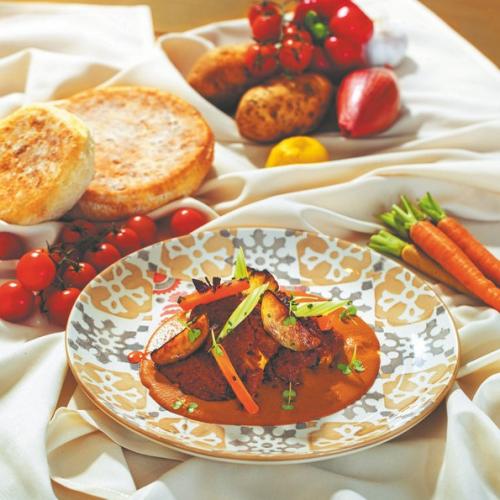


With ingredients spanning time and cultures, food in Macao is something to savor.
Few places have such a reputation for dishing up creativity as Macao. You can taste the difference, literally, in the special administrative region of China.
And it is still evolving. Amid the culinary landscape of the past decade, fusion cuisine has emerged as a prominent trend, with chefs from diverse backgrounds crafting innovative creations by blending elements from different culinary traditions.
In Macao, the roots of fusion cuisine actually run much deeper, spanning at least four centuries — the cuisine is acknowledged by UNESCO as the world's inaugural fusion food.
This unique culinary tradition traces its origins to the age of maritime exploration, recording a symphony of flavors that has matured and settled, indeed marinated, in Macao over time.
This cuisine not only melds ingredients, spices and cooking techniques but also seamlessly intertwines cultures and histories, creating an outstanding culinary tapestry.

However, despite its rich history, the cuisine remains a relatively undiscovered gem, frequently mischaracterized as a mere extension of Cantonese cooking.
Encapsulating the essence of centuries-old cross-cultural influences, it has been enlisted among China's National Intangible Cultural Heritage, as well as being added to Macao's intangible cultural heritage list.
Macao was named a Creative City of Gastronomy by UNESCO in 2017. The local government has since introduced a comprehensive set of initiatives to enhance the preservation and inheritance of its cuisine. Chefs have also made a sustained effort to help this historical record of the city to continue to shine.
Today, its food stands as a cherished classic, widely favored by tourists.
In Ana Manhao Sou's mind, this cuisine embodies the home-cooked meals of Macao-born Portuguese.
Sou, 61, was born and raised in Macao after her parents emigrated from Portugal in the 1950s.
Fluent in Cantonese, with a Western appearance, she is a genuine Macao native. Following her retirement in 2013, she ventured into the culinary scene by opening Belos Tempos.

Located in Rua da Felicidade, one of Macao's most historic and tourist-centric streets, the small two-story restaurant serves Portuguese and Macao food. The menus at the restaurant are written in English, Portuguese and Chinese.
Sou is keen on creating Macao food and spreading the word about its traditional and cultural value.
"I learned to cook from my mom. My cuisine combines ingredients from Portugal and China, and you can also taste my mom's flavors in it," Sou says.
Sou highlighted that a rich variety of spices is a notable characteristic.
The culinary tradition embraces spices from India, Indonesia, and ingredients from other countries along the maritime trade route, including curry, pepper, cloves, cinnamon, turmeric and saffron.
Tacho is one of Sou's signature dishes, representing the quintessential flavors of a Portuguese household in Macao. According to her, the term tacho in Portuguese translates to big plate.
This dish holds special significance for Portuguese families in Macao during Christmas, as Sou explains: "While turkey might not grace our table, tacho is a must, enjoyed only once a year."
Tacho is a culinary mosaic, combining diverse Chinese and Western ingredients. Sou emphasizes the individuality of each family's tacho, with variations reflecting treasured, handed-down recipes. Common components include stewed chicken, pig's trotters, cured duck legs, sausages, fried pig skin, and cabbage.

"In our family's tacho, we skip the mushrooms and used to include beef, but I've omitted it now," Sou says.
Originally a winter delicacy, Sou sometimes caters to demand by preparing the dish for guests during the summer. "Whether consumed by locals or tourists, this dish exudes a sense of home," adds Sou.
Sou believes that another feature of the cuisine is the meticulous chopping of ingredients. This practice originated for two main reasons: first, in Portuguese households, often large and communal, finely chopped food facilitates easy sharing among family members. Second, chopping ingredients into small pieces increases the quantity, offering a practical way to manage household expenses.
"Although dishes in our cuisine cook quickly, the preparation demands a significant amount of time, especially when it comes to finely chopping various ingredients," Sou explains.
Minchi is another classic dish, with the name derived from the English word mince. There are various cooking methods for minchi, using meat that can be pork, beef or a mix of both, sometimes turkey or shrimp, alongside pickled vegetables, fried potato cubes, Portuguese cured sausages, among other ingredients.

Minchi rice is one of Sou's specialties. She stir-fries minced pork with diced potatoes, serving it with a perfectly fried sunny-side-up egg.
Sou believes that the current momentum of traditional cuisine is promising, thanks to the support from the local government. She is also enthusiastic about teaching young individuals how to cook all the dishes in her repertoire.
When discussing Macao food, Bacalhau, deserves a special mention. It's crafted from salted and preserved cod, while boasts versatility — suitable for grilling, roasting, braising and even raw consumption. It was served as a convenient preserved food in previous generations. Found on the menus of numerous restaurants across Macao, it is always a popular choice, especially in the form of Bacalhau Croquettes, in which cod and mashed potatoes are shaped into balls and deep-fried.
At the Coast restaurant in Macao, Bacalhau Croquettes shine as one of the best-selling dishes. Chef Jefferson Lim has added innovative touches while preserving the traditional essence of the dish.
While the traditional Bacalhau Croquettes are typically savored on their own, Lim, recognizing the local preference for sauces accompanying fried foods, has thoughtfully paired them with two homemade sauces: a custom egg yolk sauce and malt vinegar.

The sweet, but not overpowering, malt vinegar sauce complements the crispy Bacalhau balls, resulting in a harmonious collision of flavors that achieves a perfectly balanced taste. Lim also adheres to the traditional oval shape of Bacalhau, ensuring guests can conveniently dip the delicacy into the sauces.
For another signature dish, African chicken, by Portuguese chef Joao Casimiro at Rossio restaurant, is a mouthwatering prospect.
Usually, the chicken is roasted with a layer of thick sauce on top, yet Casimiro serves a different smooth sauce beneath it to make it even more flavorful.
Casimiro boasts an impressive 16-year career in the culinary field. After gaining experience in Portugal and subsequently relocating to Milan, he has dedicated the last five years of his culinary journey to Macao.
Since his arrival in Macao, the 38-year-old chef has actively immersed himself in the world of its cuisine. "The cuisine here is a full fusion of cultures that developed throughout the years and mainly in people's homes, in families, not in restaurants like here," he says, adding that each family had their own recipes and some have, regrettably, been lost to time.
"I think that the younger generations should research their family recipes and create a database," he says.
If you have any problems with this article, please contact us at app@chinadaily.com.cn and we'll immediately get back to you.